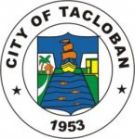

The City of Tacloban (Waray: Ciudad han Tacloban, Tagalog or Filipino: Lungsod ng Tacloban) is a port city approximately 360 miles southeast of Manila. It is the first in Eastern Visayas to be classified as a Highly Urbanized City. It is the capital of the Philippine province of Leyte and is the largest city in terms of population in Eastern Visayas. It is also considered as the regional center of the Region VIII. Tacloban was briefly the seat of the Philippine Commonwealth Government, from October 20, 1944 to February 27, 1945.
In an extensive survey conducted by the Asian Institute of Management Policy Center and released in July 2010, Tacloban City was ranked among the top ten most competitive cities in the Philippines. Tacloban ranked fifth overall, and second in the emerging cities category.

Tacloban was first known as Kankabatok, an allusion to the first inhabitants of the place – Kabatok. They established their dwelling in the vicinity of the present day Sto. Niño Church. Others who came later were Gumoda, Haraging and Huraw who erected their own settlements in nearby sites. Huraw’s domain is the hill where the city hall now sits. The combined settlements acquired the name Kankabatok, meaning Kabatok’s property.
By the end of the 16th century, Kankabatok was under the political administration of Palo and part of the parish of Basey, Samar. It was discovered in 1770, by the Augustinian Mission, who were superseded by the Franciscans in 1813. During this period, Kankabatok was renamed to Tacloban.

Street performers carrying Taklubon their backs. Tacloban got its name from these taklubs.
The change of the name came about in this manner: Kankabatok was a favorite haunt of fishermen. They would use a bamboo contraption called “Taklub” to catch crabs, shrimps or fish. When asked where they were going, the fishermen would answer, “(to) Tarakluban”, which meant the place where they used the devise to catch these marine resources. Eventually, the name Tarakluban or Tacloban took prominence.
It is not known when Tacloban became a municipality because records supporting this fact were destroyed during a typhoon. It is commonly believed that Tacloban was officially proclaimed a municipality in 1770. In 1768, Leyte and Samar were separated into two provinces, each constituting as a politico-military province. Due to its strategic location, Tacloban became a vital trading point between the two provinces.

One of the reasons Tacloban became the capital is her well-sheltered sea port
The capital of Leyte was transferred from one town to another with Tacloban as the last on February 26, 1830. The decision to make Tacloban the capital was based on the following reasons: 1) ideal location of the port and 2) well-sheltered and adequate facilities. On June 20, 1953,[1] Tacloban was proclaimed a chartered city by virtue of Republic Act No. 760.
The arrival of Colonel Murray in 1901 made him the first military governor of Leyte. His first official act was the opening of Tacloban port to world commerce. Before World War II, Tacloban was the commercial, education, social and cultural center of the Province of Leyte. Copra and abaca were exported in large quantities. The leading institutions were: The Leyte Normal School, Leyte High School, Leyte Trade School, Holy Infant Academy and the Tacloban Catholic Institute.
On May 25, 1942, Japanese forces landed in Tacloban – signaling the beginning of their two-year occupation of Leyte. They fortified the city and improved its airfield. Since San Pedro Bay was ideal for larger vessels, the Japanese Imperial Naval Forces made Tacloban a port of call and entry. This time was considered the darkest in the history of Tacloban and the country due to the incidences of torture among civilians, including the elderly. In response, guerrilla groups operated in Leyte – the most notable of which was the group of Colonel Ruperto Kangleon.
Leyte was the first to be liberated by the combined Filipino and American troops. General Douglas MacArthur’s assault troops landed in the Tacloban and Palo beaches (White Beach and Red Beach, respectively) and in the neighboring town of Dulag (Blue Beach) on October 20, 1944. These landings signaled the eventual victory of the Filipino and American forces and the fulfillment of MacArthur’s famous promise: “I Shall Return.”
Three days later, on the 23rd, at a ceremony at the Capitol Building in Tacloban, General MacArthur accompanied by President Sergio Osmeña made Tacloban the temporary seat of the Commonwealth Government and subsequently the temporary capital of the Philippines until the complete liberation of the country. The provincial government of Leyte and the municipal government of Tacloban were re-established.
Atty. Paulo Jaro was the Liberation Mayor of Tacloban. The first mayor of this capital upon inauguration of the Philippine Republic was Hon. Epifanio Aguirre. On January 8, 1960, GeneralDouglas MacArthur made his “sentimental” journey to Leyte.

Price mansion. General Douglas MacArthur set up headquarters in a building owned by Capt. and Mrs. Walter Scott Price in 1944. The general escaped injury in this building when a Japanese bomb penetrated the roof over his room on October 20, 1944. It served as the provisional capitol of the Philippines from October 20–23, 1944 upon the reconstitution of the Commonwealth of the Philippines for President Osmeña. It is now occupied by an insurance company
Landmarks in the area include the Joseph Price Mansion where General MacArthur set up headquarters in 1944 and the Redoña Residence. These two structures in Tacloban played a vital role during the liberation of the Philippines.
The city has been proclaimed as a highly-urbanized city by President Gloria Macapagal Arroyo on October 4, 2008[5] and ratified by the people on December 18, 2008.









